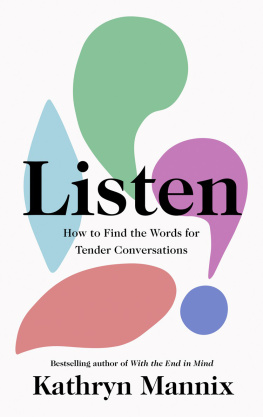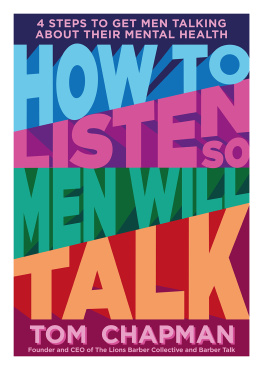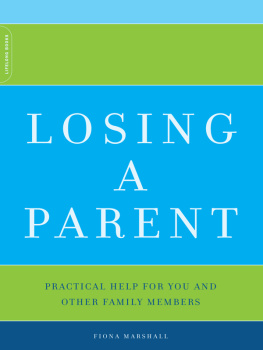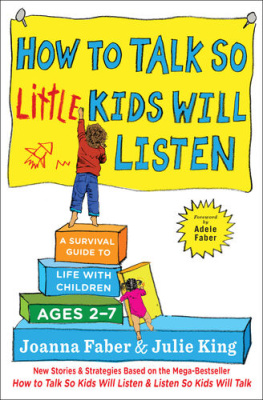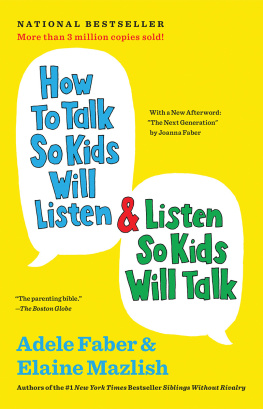LISTEN
How to find the words for tender conversations
Kathryn Mannix

William Collins
An imprint of HarperCollinsPublishers
1 London Bridge Street
London SE1 9GF
WilliamCollinsBooks.com
HarperCollinsPublishers
1st Floor, Watermarque Building, Ringsend Road
Dublin 4, Ireland
This eBook first published in Great Britain by William Collins in 2021
Copyright Kathryn Mannix 2021
Cover design by Ellie Game
Kathryn Mannix asserts the moral right to be identified as the author of this work
A catalogue record for this book is available from the British Library
Thanks for reading this book. Its important to note that it is not a medical textbook, and its contents are not a substitute for medical advice. Please always seek the advice of a qualified professional healthcare provider if you have questions or concerns about your own physical or mental health, and advise/support others to do so, too.
Information on previously published material appears .
All rights reserved under International and Pan-American Copyright Conventions. By payment of the required fees, you have been granted the non-exclusive, non-transferable right to access and read the text of this e-book on-screen. No part of this text may be reproduced, transmitted, down-loaded, decompiled, reverse engineered, or stored in or introduced into any information storage and retrieval system, in any form or by any means, whether electronic or mechanical, now known or hereinafter invented, without the express written permission of HarperCollins
Source ISBN: 9780008435431
Ebook Edition September 2021 ISBN: 9780008435455
Version: 2021-08-03
To the patients, families, colleagues and mentors who shaped my practice. Thank you will never be enough.
Contents
I cant find the words.
Right now, there is quite likely to be a conversation you are trying to avoid. It is probably one that is important to you, but it has a quality of discomfort to it. Perhaps the conversation requires sharing of a difficult truth; enquiring about information that may be life-changing; proposing something that risks rejection; discussing a topic that will unleash strong emotions; consoling someone experiencing sorrow. There is a push-pull of commitment: the need to act and yet the fear of vulnerability. Not just yet. Soon, but not just yet: I will call, or visit, or make that appointment. We stand on the brink, unsure how to begin.
We all have moments when words fail us. Often this is because the words we need are swirling in a fog of emotions; sometimes leaving them hidden seems more appealing than taking the risk of putting a distressing situation into words.
There are moments when a look, a touch, a shrug, a nod might communicate better than words. A hug, the clasp of a hand, a pat on the arm may speak volumes. Some of us are more comfortable than others with physical gestures; sometimes we might offer a cup of tea, a handkerchief, or a companionable silence.
But eventually there comes a time for words, and then the word-finding difficulty begins. Perhaps we know what we want to convey, but the words feel inadequate. Perhaps we wish we could talk about something important to us, but we fear becoming emotional in speaking of it. We may want to ask a question yet fear it will seem intrusive or insensitive. Maybe it is bad news that needs to be broken, and we dread the distress we will cause in pursuing the task.
This book is about those moments. It offers some ways into finding the words and enabling conversations. It draws on a fascination with the ways we communicate with one another that I have explored throughout my life in social and professional relationships, and it is informed by my work as a doctor, psychotherapist and trainer. Rather than suggesting a script to follow, this book offers stories to think about alongside a discussion of some skills and principles to trust. I hope this combination will give you a handle on the conversations of significance that lie ahead for you, and some ideas to adapt for the situations that you find yourself facing.
A word about stories: throughout this book I have used stories to illustrate the principles of communication. Some of them are my own experiences, some are other peoples that they have discussed with me and some are fictional representations of common human experiences. Names and other details of the real people have been changed to protect their identities, and the book does not distinguish the real from the imaginary: all are here simply to provide examples for readers to reflect on, to illustrate or illuminate their own life experiences.
The skills involved in important conversations are nuanced and layered. They are not tools to be used one at a time, but are more like the movements you make to join in a dance: stepping, turning, pausing, changing direction and keeping in time to the music as we move together around the dancefloor. And a bit like salsa dancing, conversations usually need at least two people, for participants to join in and to take turns. Perhaps one person is leading, and yet not forcing. Perhaps one is following, and yet not under pressure. As a dance or a conversation continues, the roles of leader and follower may swap. And in the same way that a dance progresses using steps forwards and backwards, sharing and preserving the space, a conversation includes words and silences, speaking and listening, statements and questions. There is consent, and there is partnership.
There is no right way to hold a conversation about matters that are serious, or sorrowful, or embarrassing, but there are some wrong ways. Getting it wrong is often not about the words themselves, but the dance: insisting on instead of inviting a discussion; speaking lots and listening little if at all; raised voices and too little silence; speaking without consent, or at the wrong time, or to get it over with rather than to explore.
Those occasions when we get it wrong cannot be undone, but we can learn from them. Like dancing: we can understand why we tripped up and know how to tread more gracefully next time; how to keep our balance; how to lean on or support each other as we progress. When to move forwards; when to step backwards; when to trust our hearts and simply follow the music.
This book is an invitation to notice and to expand a skill set that we all possess: our innate ability to join in conversations. Rather than being a textbook or like a dance lesson, it is more of an exhibition or a dance festival where both beginners and accomplished artists can be observed. Instead of training, this book offers encouragement: we will consider ways to open conversations that previously felt too daunting; we will examine how to feel our way into them gently and hold the space there that allows our conversations to flourish.
The style and skills we use will overlap; some we will use all the time, in the same way as dancers move to the rhythm of the music, keep balance and work together. Such skills are like basic steps, while others are turns or twirls that we will use only occasionally. The skills are presented in a roughly sequential order: first, those to engage in a conversation, to get alongside another person and gain their confidence and trust, to begin the process of discovering their current position.
Having looked at those basic skills to open up a conversation, we will observe them again as they are put to use, with only a slightly different emphasis, to explore possibilities for change, or agreement, or resolution. The style remains the same: we are working with, not doing to, the other person, acting as partners, working together to keep in step.

